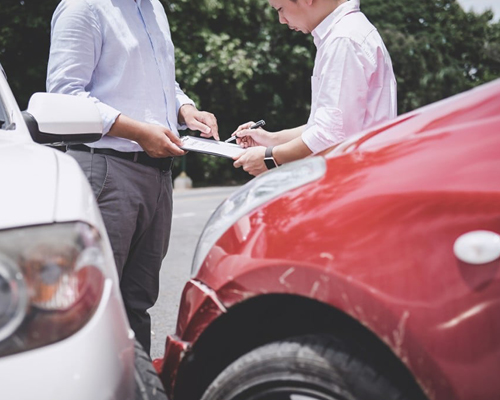Insight

What Do I Do If I’m in a Car Accident?
“I’ve been in a car accident.”
No one ever wants to whisper those dreaded words. Any car accident is a frightening and stressful experience, no matter how small it is.
After being involved in a car accident, people tend to feel a little disoriented and confused. In those moments directly after the accident, things seem a bit chaotic and overwhelming. Making the right decisions and taking the necessary steps during that time can be downright impossible if you’re not prepared.
Once you’ve been in a car accident, you’ll want to get yourself together and make sure everyone is safe. You will also need to start gathering information. However, many people find themselves all out of sorts and unable to think clearly. Taking the time to learn what to do once you’ve been in a car accident can help you make the necessary decisions if the time comes.
Be Prepared
You don’t want to think about being in a car accident and hopefully, you won’t ever experience one. However, the best thing you can do is to prepare for one, just in case.
Put some things in your glove box that you’ll need if you get in an accident. This includes a notebook and a pen so that you are ready to write down the information that you need. You should also keep a flashlight and a first-aid kit, both of which could come in handy after a car accident.
Being prepared really can make all the difference after a car accident. Keep calm, maintain your composure, grab your tools, and be ready to take the next steps.
Examine Yourself and Your Passengers for Injuries
As soon as that accident happens you need to check everyone over for injuries. If there are small injuries, you might be able to take care of them using your first aid kit. Make sure the person stays still if there are larger injuries or pains in the neck or back. Have them wait for emergency responders who will be prepared to help with any large issues. If you haven’t called 911 yet, now is the time.
Turn on Hazards
Once you’ve determined that everyone is safe, you’re going to want to put your hazard lights on. This warns oncoming drivers that your car is stationary and they need to go slow and be aware. If you are able to move your car to the side of the road and out of traffic, do so. If your car is unable to move, keep it there but make sure the hazards are on.
Check on Occupants of the Other Vehicle
After you have gotten the car secured, go over and check on the occupants of the other vehicle. You may be able to help them using your first aid kit, or to secure them until paramedics arrive. Depending on the severity of their injuries, you may want to call 911 again to inform them of the person’s situation.
Exchange Names and Insurance Information with the Other Driver
As long as you are in a safe location and both of you are free from severe injuries, you will want to exchange essential information with the other driver. The information you’ll want to collect includes their name and contact information, their insurance information, their license plate and car make/model, and any witness contact information, if applicable.
Take Pictures
Assuming you have your phone on you, make sure and take pictures if it’s possible and you can safely do so. Get photos of the scene, of all cars involved, of signs in the area, and road conditions. These will come in handy for any legal and insurance reasons. You can even take a video of the scene for a more detailed overview.
Get Checked Out
If there is any possibility that you or one of your passengers could be injured, get checked out by a doctor right away. Oftentimes, victims of car accidents don’t feel their pains for a day or two. By letting a medical professional determine your condition, you’ll prevent further damage and get started on the path to healing much quicker.
File a Report
Head online to file a report of your accident with the DMV or police. In many states, it’s illegal not to do so. Filing should be simple, especially since you were prepared to take notes and take photos.
Call Your Insurance
When you’re finally home after the accident, it’s time to call your insurance company. Notify them of the accident and get your claim going. Once you supply the basic information, you can expect to hear from an insurance adjuster who will be leading your claim. They will likely want your photos and may even need to see your vehicle. Be prepared to work with the adjuster as they figure out what to pay you for repairs or replacement.
The Final Word
Hopefully, you never have to deal with the aftermath of a car accident, however, it’s always best to be prepared. Take some time to prepare and develop a plan of attack so that you’re ready to handle an accident with as much ease as possible. In the course of those plans, make sure your car and life insurance are all up to date. If you need assistance, reach out to a member of our team today!